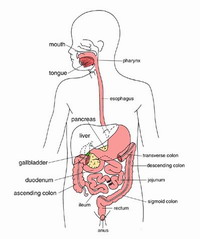Login form
Digestive System
 You eat when you get hungry. It seems so simple. You take a bite out of a sandwich.
You eat when you get hungry. It seems so simple. You take a bite out of a sandwich.
That bite then begins an amazing journey. That bite goes through every part of your digestive system. Your body digests, or breaks down, the food into smaller and smaller parts. At the end of the journey your blood carries chemicals from your sandwich to every part of your body.
WHAT IS YOUR DIGESTIVE SYSTEM LIKE?
Your digestive system is one long, winding tube. The digestive system of a grown-up is 20 to 30 feet (6 to 9 meters) long.
Food goes from your mouth to your throat. It then slides down a tube called the esophagus. It drops into your stomach. From there it gets squeezed into your small and large intestines.
WHERE DOES DIGESTION START?
You start to digest food in your mouth. You bite off a piece of sandwich. Your teeth grind the bite up. Your mouth waters with a liquid called saliva. Saliva helps make the bite of chewed-up sandwich soft and wet.
After you chew up the bite of sandwich, you swallow it. Your tongue pushes the chewed-up food into your esophagus. Your esophagus is like a chute that sends the food into your stomach.
WHAT HAPPENS IN YOUR STOMACH?
Your stomach breaks down the food even more. Your stomach is like a bag made of muscles. Liquids called digestive juices pour into your stomach. Your stomach muscles churn the food around to mix it with the juices. The juices break down the food. The food turns into a liquid in your stomach.
That bite of sandwich does not look like bread, lettuce, cheese, or meat anymore. It is broken down into chemicals called fats, proteins, starches, and sugars.
It takes your stomach about four hours to do its job. Your stomach then sends the liquefied food on to your small intestine. You start to feel hungry again when your stomach is empty. Sometimes your stomach muscles start to churn when your stomach is empty. When this happens, you can hear your stomach growl.
WHAT HAPPENS IN YOUR SMALL INTESTINE?
The job of digesting your sandwich gets finished in your small intestine. Your small intestine is a long and narrow, twisty tube. The small intestine is by far the longest part of the digestive system. Muscles surrounding this tube push the liquid along. More juices break the food down even further.
Eventually the food is broken down into chemicals that your body can use. These chemicals go through the wall of your small intestine. They go into tiny blood vessels just outside the wall. Your blood picks up the chemicals. Your blood carries them to every part of your body. The food chemicals go from your blood into your cells. Your cells use the chemicals to make the energy you need to do your homework, run, and play.
Other organs around your small intestine help it digest food. Your liver and gallbladder help digest fats in foods. Your liver also helps your body store extra food that it cannot use right away. Your pancreas creates the chemical insulin. Insulin helps your body use sugar.
There are some leftovers that get to the end of your small intestine. The leftovers go into your large intestine.
WHAT HAPPENS IN YOUR LARGE INTESTINE?
Your large intestine is shorter and thicker than your small intestine. Your large intestine takes water out of the leftovers. It also takes out some vitamins and minerals.
Bacteria that live in your large intestine break down any leftover food. Bacteria are tiny living things that you can only see with a microscope. What is left in your large intestine is solid waste.
Muscles in your large intestine push the waste along. It goes from your colon to your rectum. The waste gets pushed out of your body through an opening called the anus.
Source: Microsoft ® Encarta

